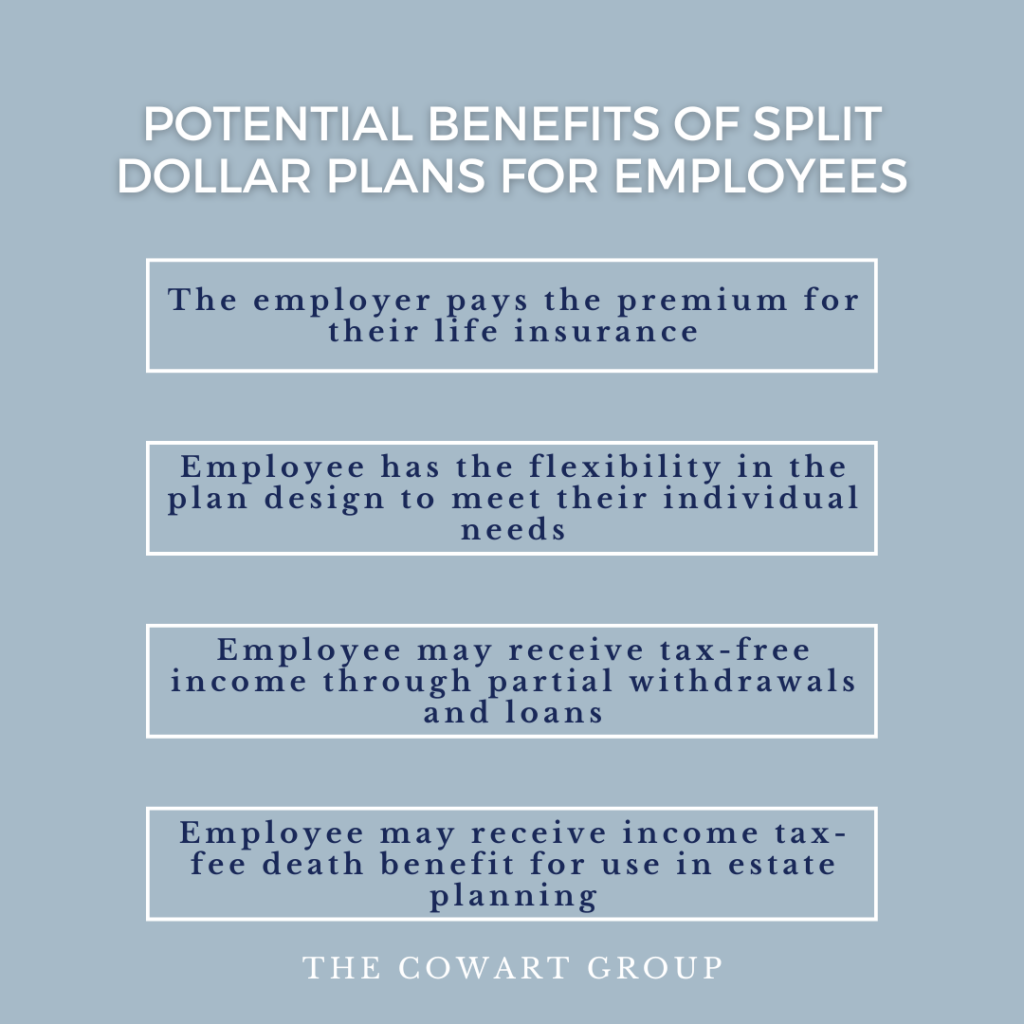Over the past decade, numerous tax law changes have reduced personal income tax rates to the lowest marginal rates in over fifty years. At the same time, additional restrictions and reporting requirements have been imposed on tax-qualified retirement plans, making them increasingly unattractive for key employees. These changes have led to the widespread implementation of executive benefit plans utilizing specially designed life insurance policies for companies of all sizes, including non-profit organizations.
Split dollar plans are growing in popularity with employers and executives who want to accumulate more money for the future. The planning specialists at the Cowart Group can show employers how this executive benefit can attract and retain top talent in a competitive employment market.
Split Dollar Plans
A split dollar plan is a contract between two or more parties to split the ownership and benefits of a cash value life insurance policy. These plans are used by companies to attract and retain key employees while helping those participants save more for retirement or assist in estate planning. A key differentiator from many other executive benefit arrangements is that split dollar plans are often used with business owners as well as top talent.
Here is how a split dollar plan works:
A split dollar plan can involve either an employer-owned or an employee-owned cash value life insurance policy that benefits both the company and the employee or owner. Every split dollar plan must involve two or more parties who share the costs and benefits of an insurance policy with the plans able to be customized in the following respects:
- Which party pays the premiums.
- Which party owns the policy.
- Which party designates the beneficiaries.
- How the death benefit and cash value are split.
- When and under what circumstances the agreement terminates.
All of these details must be described in the contract establishing the split dollar plan.
Who owns the life insurance policy?
The following are the common ownership models:
- Employee-owned: the employee owns the life insurance policy while another party makes part or all the payments.
- Employer-owned: similar to key person insurance, the employer owns the policy and uses its portion of the payout to recoup business expenses related to the employee’s death.
- Shareholder partner-owned: small business partners and shareholders or closely held companies may include a split dollar arrangement in their buy-sell agreement, which dictates what happens if one owner exits the business.
- Trust-owned: an alternate structure to having an owner or employee own the life insurance policy. The policy is placed in an irrevocable life insurance trust, preventing the assets from being counted in the value of an estate.
At the Cowart Group, we work with our corporate clients in designing split dollar arrangements that fit each, unique situation and meet desired compensation goals.
Types of Split Dollar Plans
The two main types of ownership agreements between companies and employees are: (1) the economic benefit/endorsement agreement; and (2) the collateral assignment/loan regime.
Economic benefit/endorsement agreement
When the company owns and pays the premiums on the life insurance policy in a split dollar plan but the employee executive and his or her beneficiaries obtain some of the benefits, such benefits are assigned to the employee through an endorsement agreement.
The term “economic benefit’ refers to the way that the Internal Revenue Service (IRS) taxes the split dollar plan. The death benefit to be received by the owner or employee is taxed on an annual basis as compensation. This amount is generally the pure term insurance costs, usually quite low until older ages.
Collateral assignment and loan regime
When the employee executive owns the cash value life insurance policy under the contract, but the company pays the premiums and obtains a portion of the policy benefits, the employee assigns such benefits to the company under a collateral assignment agreement.
The IRS treats the premiums paid by the company as an annual, interest-free loan to the employee (i.e., a loan regime). The company’s share of the policy benefits is treated as repayment for the loan. The employee pays tax on the interest that would have been charged if the contract was a traditional loan arrangement (known as the applicable federal rate or “AFR”).
Loan regime contracts potentially have greater tax benefits for the employee because the employee is not taxed on the value of the split dollar plan’s policy benefits. However, in a period of rising interest rates, the loan costs can become expensive. When loan rates rise, it may be wise for a collateral assignment split dollar plan to use “economic benefit” treatment instead of a loan regime. The Cowart Group can help in this determination so that split dollar benefits are maximized, and costs are controlled.
Split Dollar for Non-Profit Organizations
Nonprofit organizations such as hospitals, charities, universities and more can also benefit from a split dollar plan in much the same manner as a for-profit company. Depending on the structure, the cash value life insurance policy can provide future income and/or income tax-free death benefit to nonprofit officers and other key employees. In addition, a split dollar plan offers the non-profit a way to address the IRS’ excise tax on highly compensated employees. This excise tax levies a 21% penalty to the non-profit on compensation, including most nonqualified distributions, of over $1 million for its top five paid executives. Split dollar plan loans are not subject to the excise tax, leading a greater number of non-profits to adopt split dollar strategies.
The Cowart Group works with a number of tax-exempt organizations in designing and implementing split dollar arrangements to attract, retain and reward key leadership.
Advantages of a Split Dollar Plan
Potential employer benefits
- Employer selects who receives benefits, when they receive them and how much they receive
- Fewer limits or rules than traditional qualified plans
- Low start-up and administrative costs
- The chance to recover a company’s costs when a participant quits, retires or dies
Potential employee benefits
- The employer pays the premiums for their life insurance
- Employee has flexibility in the plan design to meet their individual needs
- Employee may receive tax-free income through partial withdrawals and loans
- Employee may receive income tax-free death benefit for use in estate planning
What Entities Use Split Dollar Plans?
Regardless of the tax election of the employer, split dollar plans universally have advantages for key employees. Either the for-profit or non-profit employer treats the premium loans as a receivable or treats the economic benefit as compensation. For owners, though, the structure of their business matters.
C Corporation
The most attractive benefit of a split dollar plan is that it allows a company owner to leverage their C-Corp tax rate, to grow funds for themselves personally:
- Rather than the premiums being taxed at their ordinary income tax rate, the premiums are taxed at only 21%.
- The owner receives all the gains on the cash value life insurance policy with no tax consequences.
- While the plan is growing or active, the corporation can access or recapture funds from the policy if needed.
- An ideal plan for any business owner who has a C-Corp that has retained earning.
S Corporation
For owners of a S-Corp, they must use after-tax dollars to fund their split dollar plans so the immediate tax benefits are not as great as those with C-Corps. Further, a split dollar plan benefitting the sole shareholder of an S-Corp, who is also an employee of the corporation, is viewed as a compensatory arrangement, with any economic benefit taxable as ordinary income and not as a tax-free S-Corp distribution.
Split dollar plans are incredibly powerful executive benefit solutions. The Cowart Group is familiar with the tax and regulatory nuances of compensation planning for both for-profit and tax-exempt organizations and can evaluate if a split dollar arrangement might be an effective solution.
Remain Competitive
In today’s labor market, companies are turning to executive benefit programs, including split dollar plans, to recruit, retain, reward, and retire key talent. The financial professionals with the Cowart Group provide tailored financial solutions to families and businesses that count on our experience and dedication to their success. Our aim to deliver quality advice derives from our relationships with insurers, our underwriting advocacy, and technology resources. We provide strategies and solutions designed to assist our clients in benefiting from and optimizing existing and changing government regulations.



